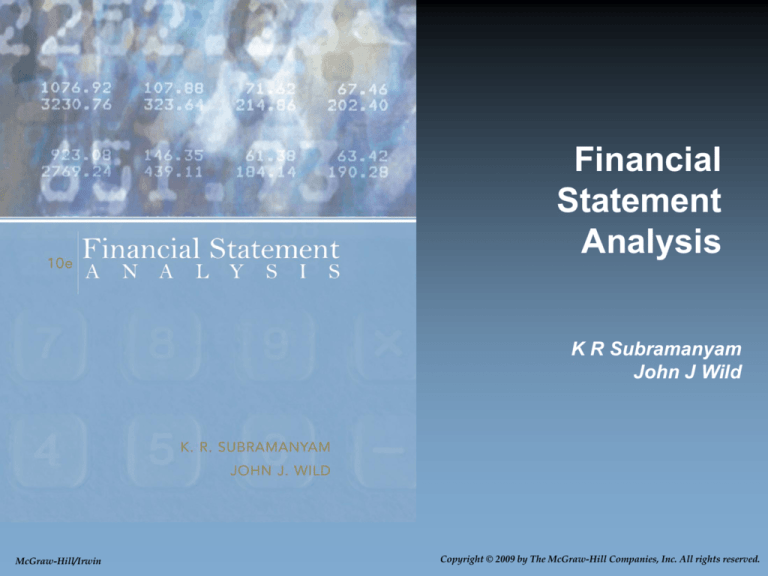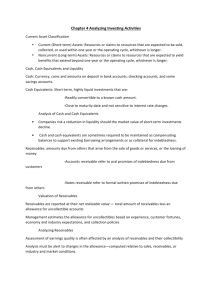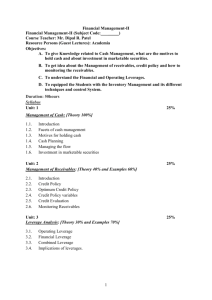
Financial
Statement
Analysis
K R Subramanyam
John J Wild
McGraw-Hill/Irwin
Copyright © 2009 by The McGraw-Hill Companies, Inc. All rights reserved.
4-2
Analyzing Investing Activities
4
CHAPTER
4-3
Current Asset Introduction
Classification
Current (Short-term)
Assets
Noncurrent (Longterm) Assets
Resources or claims to
resources that are
expected to be sold,
collected, or used within
one year or the operating
cycle, whichever is
longer.
Resources or claims to
resources that are
expected to yield
benefits that extend
beyond one year or the
operating cycle,
whichever is longer.
4-4
Current Asset Introduction
Cash, Cash Equivalents and Liquidity
Cash
Currency, coins and amounts on deposit
in bank accounts, checking accounts, and
some savings accounts.
4-5
Current Asset Introduction
Cash, Cash Equivalents and Liquidity
Cash Equivalents
Short-term, highly liquid investments that are:
Readily convertible to a known cash
amount.
Close to maturity date and not
sensitive to interest rate changes.
4-6
Current Asset Introduction
Analysis of Cash and Cash Equivalents
• Companies risk a reduction in liquidity should the
market value of short-term investments decline.
• Cash and cash equivalents are sometimes required
to be maintained as compensating balances to support
existing borrowing arrangements or as collateral for
indebtedness.
4-7
Current Asset Introduction
Receivables
Receivables are amounts due from others
that arise from the sale of goods or services,
or the loaning of money
Accounts receivable refer to oral promises
of indebtedness due from customers
Notes receivable refer to formal written
promises of indebtedness due from others
4-8
Current Asset Introduction
Valuation of Receivables
Receivables are reported at their net realizable
value — total amount of receivables less an
allowance for uncollectible accounts
Management estimates the allowance for
uncollectibles based on experience, customer
fortunes, economy and industry expectations,
and collection policies
4-9
Current Asset Introduction
Analyzing Receivables
Assessment of earnings quality is often affected by an analysis of receivables and their
collectibility
Analysis must be alert to changes in the allowance—computed relative to sales,
receivables, or industry and market conditions.
Two special analysis questions:
(1) Collection Risk
Review allowance for uncollectibles in light of industry conditions
Apply special tools for analyzing collectibility:
• Determining competitors’ receivables as a percent of sales—vis-à-vis the
company under analysis
• Examining customer concentration—risk increases when receivables are
concentrated in one or a few customers
• Investigating the age pattern of receivables—overdue and for how long
• Determining portion of receivables that is a renewal of prior receivables
• Analyzing adequacy of allowances for discounts, returns, and other credits
(2) Authenticity of Receivables
Review credit policy for changes
Review return policies for changes
Review any contingencies on receivables
4-10
Current Asset Introduction
Securitization of Receivables
Securitization (or factoring) is when a company sells all or a
portion of its receivables to a third party
Receivables can be sold with or without recourse to a buyer
(recourse refers to guarantee of collectibility)
Sale of receivables with recourse does not effectively transfer risk
of ownership
•For securitizations with any type of recourse, the seller
must record both an asset and a compensating liability
for the amount factored
•For securitizations without any recourse, the seller
removes the receivables from the balance sheet
4-11
Current Asset Introduction
Prepaid Expenses
Prepaid expenses are advance payments for services or goods not
yet received that extend beyond the current accounting period—
examples are advance payments for rent, insurance, utilities, and
property taxes
Analysis of Prepaids
Two analysis issues:
(1) For reasons of expediency, noncurrent prepaids sometimes
are included among prepaid expenses classified as current-when their magnitude is large, they warrant scrutiny
(2) Any substantial changes in prepaid expenses warrant
scrutiny
4-12
Inventories
Definitions
Inventories are goods held for sale, or goods
acquired (or in process of being readied) for
sale, as part of a company’s normal
operations
Expensing treats inventory costs like period
costs—costs are reported in the period when
incurred
Capitalizing treats inventory costs like product
costs—costs are capitalized as an asset and
subsequently charged against future
period(s) revenues benefiting
from their sale
4-13
Inventories
Inventory Costing Method
Use of Inventory Methods in Practice
LIFO
30%
Weighted
Average
20%
FIFO
46%
Other
4%
4-14
Inventories
First-In, First-Out (FIFO)
Oldest
Costs
Costs of Goods
Sold
Recent
Costs
Ending
Inventory
4-15
Inventories
Last-In, First-Out (LIFO)
Recent
Costs
Costs of
Goods Sold
Oldest
Costs
Ending
Inventory
4-16
Inventories
Average Cost
When a unit is sold, the
average cost of each
unit in inventory is
assigned to cost of
goods sold.
Cost of
Units
Goods
÷ available on
Available for
the date of
Sale
sale
4-17
Inventories
Illustration of Costing Methods
Inventory on January 1, Year 2
Inventories purchased
during the year
Cost of Goods available
for sale
40 @ $500
$ 20,000
60 @ $600
36,000
100 units
$ 56,000
Note: 30 units are sold in Year 2 for $800 each for total
Revenue of $24,000
4-18
Inventories
Illustration of Costing Methods
FIFO
LIFO
Average
Beginning
Inventory
$20,000
$20,000
$20,000
+
+
+
+
Net
Purchases
$36,000
$36,000
$36,000
=
=
=
=
Cost of
Goods Sold
$15,000
$18,000
$16,800
+
+
+
+
Ending
Inventory
$41,000
$38,000
$39,200
Assume sales of $35,000 for the period—then gross profit under each
method is:
Sales
– Cost of Goods Sold =
Gross Profit
FIFO
$24,000
-- 15,000
=
$9,000
LIFO
$24,000
-- 18,000
=
$6,000
Average
$24,000
-- 16,800
=
$7,200
4-19
Economic Profit vs. Holding Gain
• In periods of rising prices, FIFO produces higher gross
profits than LIFO because lower cost inventories are
matched against sales revenues at current market
prices. This is sometimes referred to as FIFO’s phantom
profits.
• The FIFO gross profit is actually a sum of two
components: an economic profit and a holding gain:
– Economic profit = 30 units x ($800 - $600) = $6,000
– Holding gain = 30 units x ($600 - $500) = $3,000
4-20
Inventories
LIFO Liquidations
(1) Companies maintain LIFO inventories in separate
cost pools.
(2) When inventory quantities are reduced, each cost
layer is matched against current selling prices.
(3) In periods of rising prices, dipping into lower cost
layers can inflate profits.
4-21
Inventories
Analyzing Inventories—Restatement of LIFO to
FIFO
Three step process:
(1) Reported LIFO Inventory + LIFO reserve
(2) Deferred tax payable + [LIFO reserve x Tax rate]
(3) Retained earnings + [LIFO reserve x (1-Tax rate)]
LIFO reserve is the amount by which current cost
exceeds reported cost of LIFO
inventories
4-22
Long-Lived Asset Introduction
Definitions
Long-lived assets—resources that are used to generate revenues (or
reduce costs) in the long run
Tangible fixed assets such as
property, plant, and equipment
Intangible assets such as
patents, trademarks,
copyrights, and goodwill
Deferred charges such as
research and development
(R&D) expenditures, and natural
resources
4-23
Long-Lived Asset Introduction
Capitalization
Capitalization—process of deferring a cost that is incurred in the
current period and whose benefits are expected to extend to one or more
future periods
For a cost to be capitalized, it must meet each of the following criteria:
• It must arise from a
past transaction or event
• It must yield identifiable and
reasonably probable future benefits
• It must allow owner (restrictive)
control over future benefits
4-24
Long-Lived Asset Introduction
Allocation
Allocation—process of periodically expensing a deferred
cost (asset) to one or more future expected benefit periods;
determined by benefit period, salvage value, and allocation
method
Terminology
• Depreciation for tangible fixed
assets
• Amortization for intangible assets
• Depletion for natural resources
4-25
Long-Lived Asset Introduction
Impairment
Impairment—process of writing down asset value when its
expected (undiscounted) cash flows are less than its carrying
(book) value
Two distortions arise from impairment:
• Conservative biases distort
long-lived asset valuation
because assets are written
down but not written up
• Large transitory effects from
recognizing asset impairments
distort net income.
4-26
Plant Assets & Natural Resources
Plant Assets
Tangible
Actively Used in Operations
Expected to Benefit Future Periods
Property, Plant and Equipment
4-27
Plant Assets & Natural Resources
Plant Assets Costing Rule
Purchase
price
Acquisition
cost
Acquisition cost excludes
financing charges and
cash discounts.
All
expenditures
needed to
prepare the
asset for its
intended use
4-28
Plant Assets & Natural Resources
Valuation Analysis
Valuation emphasizes objectivity of historical cost, the
conservatism principle, and accounting for the money
invested
Limitations of historical costs:
• Balance sheets do not purport to reflect market values
• Not especially relevant in assessing replacement values
• Not comparable across companies
• Not particularly useful in measuring opportunity costs
• Collection of expenditures reflecting different
purchasing power
4-29
Plant Assets & Natural Resources
Depreciation
Depreciation is the process of allocating the
cost of a plant asset to expense in the
accounting periods benefiting from its use.
Balance Sheet
Acquisition
Cost
(Unused)
Cost
Allocation
Income Statement
Expense
(Used)
4-30
Plant Assets & Natural Resources
Factors in Computing Depreciation
The calculation of depreciation requires
three amounts for each asset:
Cost.
Salvage Value.
Useful Life.
Depreciation Method
4-31
Plant Assets & Natural Resources
Comparing Depreciation Methods
Straight-Line Method
Depreciation
=
Expense per Year
Cost - Salvage Value
Useful life in periods
SL
4-32
Plant Assets & Natural Resources
Double-Declining-Balance Method
Step 1:
Straight-line
depreciation rate
Step 2:
Double-decliningbalance rate
Step 3:
Depreciation
expense
=
100 %
Useful life
=
= 2 ×
Straight-line
depreciation rate
Double-decliningbalance rate
Ignores salvage value
×
Beginning period
book value
4-33
Plant Assets & Natural Resources
Activity (Units-of-Production) Method
Step 1:
Depreciation
Per Unit
=
Cost - Salvage Value
Total Units of Production
=
Depreciation
Per Unit
Step 2:
Depreciation
Expense
×
Units Produced
in Period
4-34
Plant Assets & Natural Resources
Natural Resources
Natural resources (wasting assets)—rights to extract or consume natural resources
Total cost,
including
exploration and
development,
is charged to
depletion expense
over periods
benefited.
Extracted from
the natural
environment
and reported
at cost less
accumulated
depletion.
Examples: oil, coal, gold
4-35
Plant Assets & Natural Resources
Depletion of Natural Resources
Depletion is calculated using the
units-of-production method.
Unit depletion rate is calculated as follows:
Cost –
Salvage Value
Total Units of Capacity
4-36
Plant Assets & Natural Resources
Depletion of Natural Resources
Total depletion cost for a period is:
Unit Depletion
Rate
Total
depletion
cost
×
Number of Units
Extracted in Period
Cost of
goods sold
Unsold
Inventory
4-37
Plant Assets & Natural Resources
Analyzing Depreciation and Depletion
• Assess reasonableness of depreciable base, useful life, and allocation
method
• Review any revisions of useful lives
• Evaluate adequacy of depreciation—ratio of depreciation to total
assets or to other size-related factors
• Analyze plant asset age—measures include
Average total life span
=
Average age
=
Average remaining life
=
Average total life span
=
Gross plant and equipment assets /
Current year depreciation expense.
Accumulated depreciation / Current
year depreciation expense.
Net plant and equipment assets /
Current year depreciation expense.
Average age + Average remaining life
(these measures also reflect on profit margins and financing requirements)
4-38
Intangible Assets
Often provide
exclusive rights
or privileges.
Noncurrent assets
without physical
substance.
Intangible
Assets
Useful life is
often difficult
to determine.
Usually acquired
for operational
use.
4-39
Intangible Assets
Accounting for Intangible Assets
Record at cost,
including
purchase price,
legal fees, and
filing fees.
Patents
Copyrights
Leaseholds
Leasehold
Improvements
Goodwill
Trademarks and
Trade Names
4-40
Intangible Assets
Analyzing Intangibles and Goodwill
Search for unrecorded intangibles and
goodwill—often misvalued and
most likely exist off-balance-sheet
Examine for superearnings as
evidence of goodwill
Review amortization periods—any likely bias is in the
direction of less amortization and can call for
adjustments
Recognize goodwill has a limited useful life--whatever
the advantages of location, market dominance,
competitive stance, sales skill, or product
acceptance, they are affected by changes in business








